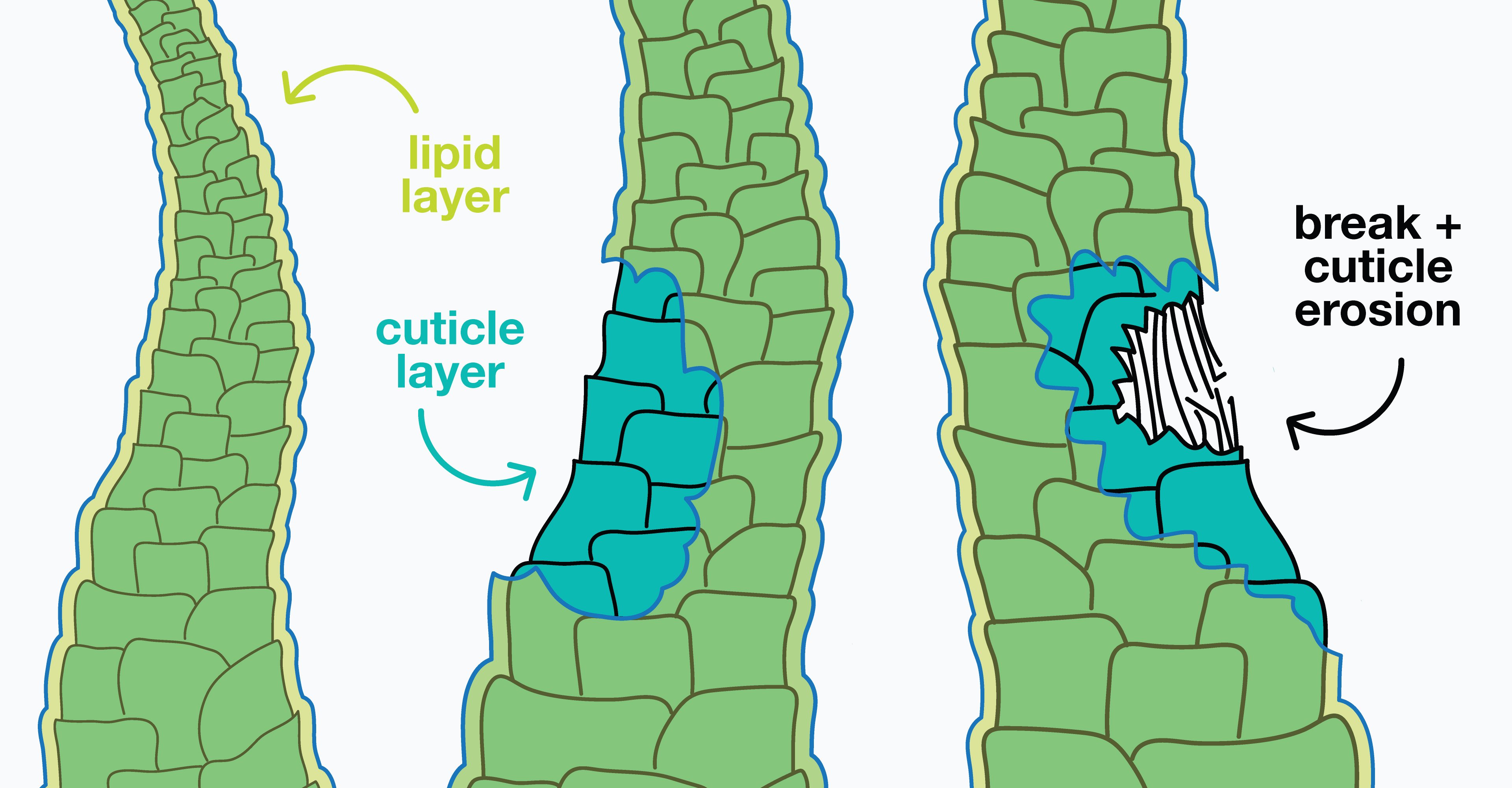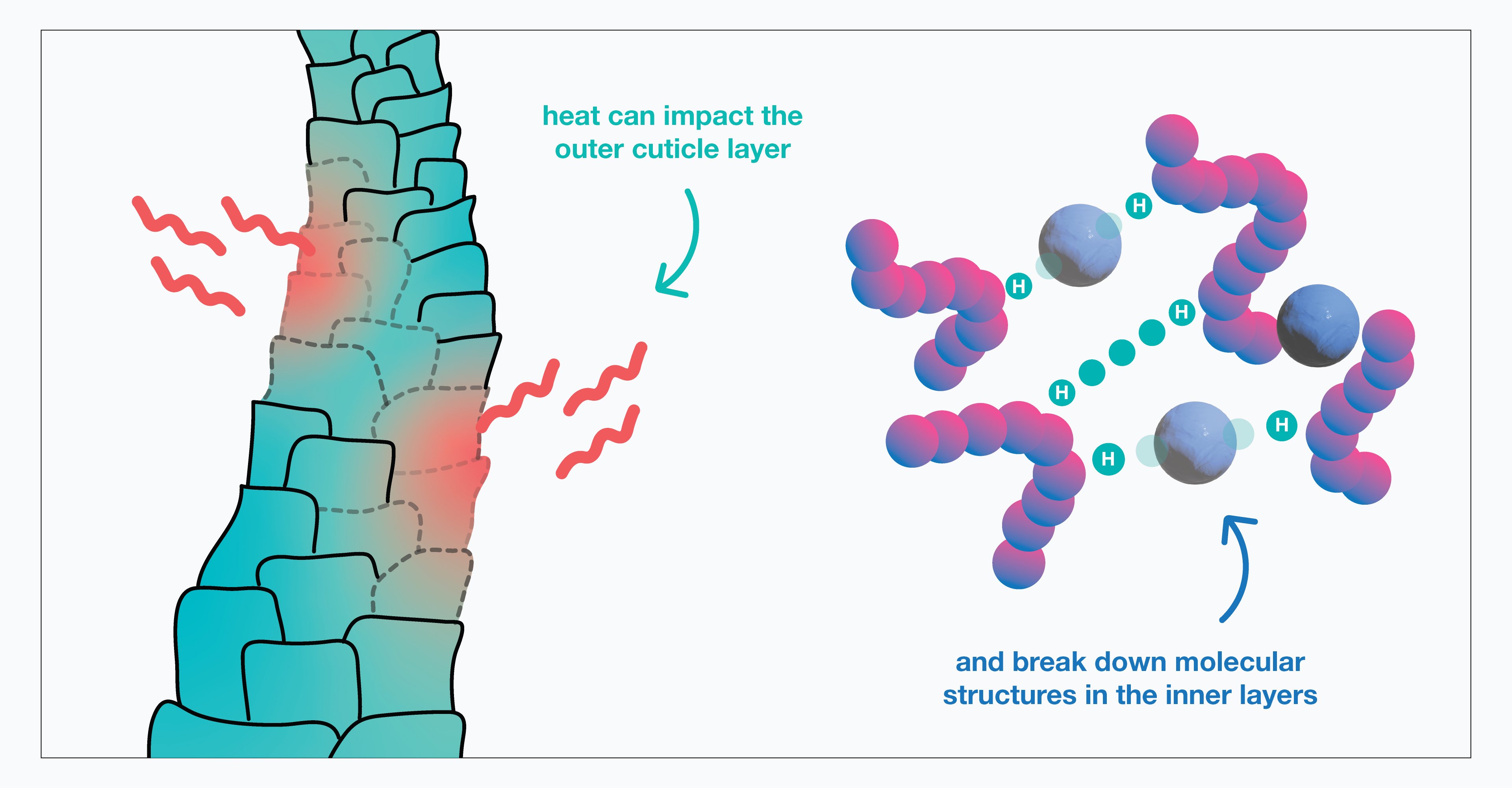Today we’re talking about hair damage. Even seemingly innocent things like washing or brushing hair can lead to damage. Just by having hair, damage is on the table.
But don’t panic. We’re going to break down how and why hair damage happens, and how to prevent it.
where does damage happen?
First, let’s uncover all the layers of hair that protect against damage. The outside of the hair fiber is covered in natural oils that act as a shield from damaging elements. Things like sun exposure, chemical services, and overwashing can strip away these natural oils, making hair rough, dull, and more susceptible to damage.
Under those natural oils lies the cuticle (cells on the outside of hair that overlap like tiles on a roof). Often this outer layer (or the protective barrier to all other layers) is one of the first things to erode due to damage. Through the damage process, those tiles begin to lift and expose the inner cortex—or the next layer— to harm. The cortex layer contains the fibrous polypeptide chains that give strands their core strength + elasticity. When these are compromised, hair can lose its bounce, shape, resilience and shine.

So there’s tons of ways to damage hair, but what’s happening scientifically when all that goes down?
heat damage
Excessive heat from hot tools can erode the hair’s cuticle layer, leaving the inner cortex vulnerable to damage. That heat can also degrade those key proteins within the cortex. As a result of existing damage, water molecules may bond with the amino acids that make up keratin chains, and get trapped between them in the cortex. When you then go to heat-style hair again, these water molecules are heated to a boiling point with no way to escape, breaking apart proteins and causing bubble deformities in the hair fibers. Commonly known as bubble hair, this heat and water combo compromises the structure of hair, making it more brittle and fragile.

pH imbalance
This is a big one that often gets left off the list. We’ve covered the importance of pH to overall hair health in a previous Science Sunday, but in case you need a refresher:
pH measures the positively charged hydrogen atoms in a solution (a mixture of two or more substances) on a scale from 0 (extremely acidic) to 14 (extremely alkaline or basic). Hair is happiest in an acidic pH range of 4.5 to 5.5, like this:

In this range, the amino acid building blocks that make up hair form the optimum amount of ionic bonds to make hair stronger.
Shifts in pH can disrupt these ionic bonds. Extremely low (~ pH 1) or high pH (~ 9+) can cause the peptide bonds in hair to break, weakening hair’s structure and contributing to even more damage, frizz, and dryness. Which can look like this:

Unfortunately, many personal care products and chemical services are not pH-optimized and have pH levels that often fall outside this healthy range. For example bleach, relaxers, and even shampoo can raise the pH of hair significantly and cause the hair fibers to swell, leading to more friction between fibers and possible damage.
It’s not all bad though, sometimes the cuticle swelling behavior at elevated pH is used intentionally. For PROs in the salon, using high and low-pH products during a chemical service can be an amazing tool to manipulate the structure of hair, and reach a desired look. Going in with pH-balanced products before or after a service can minimize and prevent further pH-induced damage.
chemical damage
This can come from more than just in-salon chemical services like bleaching, coloring, perming, and relaxing—even water or the environment can contribute to chemical damage to hair.
Many ingredients in chemical services can break the peptide bonds and other bonds deep within the cortex of hair, either intentionally (like separating and reconfiguring disulfides to set hair into a new shape and style) or incidentally (like the oxidizing agents in bleach that degrade melanin, while inflicting collateral damage to the structural proteins in hair). Breaking these crucial bonds weakens the hair fibers, decreasing hair strength and elasticity.
product, mineral, and metal buildup
All tap water contains some level of trace metals and minerals that can damage hair. Metals like calcium and magnesium, the culprits behind hard water, can cause hair to feel rough and dry, primarily impacting texture. Trace metals like copper, lead, cadmium, etc. can interact with salon services + chemicals used on hair, ultimately causing more damage to hair proteins. For metal + mineral buildup, a good demineralizing treatment can help, but product buildup is a whole different ballgame.
When excess natural oils or product builds up on hair’s surface, they act as a sticky trap for damaging minerals + metals, dirt, and pollutants. This can disrupt the scalp microbiome and throw it off balance, compromising hair from the root. Even worse, these oils can be oxidized and transformed by UV from sunlight into reactive compounds that can damage both skin and hair. More on that next….
environmental damage
While you’re enjoying a day out in the sun, ultraviolet (UV) rays excite hair molecules. This forms highly reactive molecules that degrade the amino-acid building blocks and oxidize the lipids on and in hair. These oxidized lipids can, in turn, oxidize the proteins in hair, acting as agents of chaos and wreaking havoc.

Damage from the sun, also known as photodamage, can also break down melanin and cause the color of hair to change, especially in more humid environments—the environmental equivalent of salon bleaching. Exposure to pollution including PMs (particulate matter), metals, and PAHs (polycyclic aromatic hydrocarbons) increases damage to both the cuticle and cortex, a process which is exacerbated further when UV from sunlight is added to the mix.
cuticle damage causes frizz
Besides damaged hair breaking more easily and looking dull and dry on the outside, it’s also more susceptible to frizz. When the hair’s cuticle layer is compromised, the water-repelling barrier that protects hair is disrupted, making the cuticle more vulnerable to swelling and water damage during washing—this is known as hygral fatigue. In humid environments, water can more easily penetrate the inner layers of hair and break the hydrogen bonds between keratin chains partially responsible for the hair’s shape, causing frizz.
A similar frizzy hair effect happens in dry environments too. You see, hair naturally carries negative charges, even more so with damaged hair. In dry environments, water is unable to dissipate these excess charges. As a result, the negatively charged hairs will repel each other, causing frizz and flyaways.
In short: where there’s damage, frizz is more likely to happen.
so how do I repair damage?
To bring back healthy, frizz-free hair, restoring all parts of the hair fiber is essential to maintaining hair’s strength and structural integrity. Taking a holistic approach to hair care and repair creates the best defense against damage.
The Damage Defense Checklist:
✓Prioritize damage repair from the inside out
✓Add pH-balanced products
✓Avoid over-brushing or excessive use of heat (especially on wet hair)
✓Try limiting hair’s sun and chemical exposure
✓ Use a detox treatment to remove buildup or a demineralizing treatment to remove metals + minerals from hair

